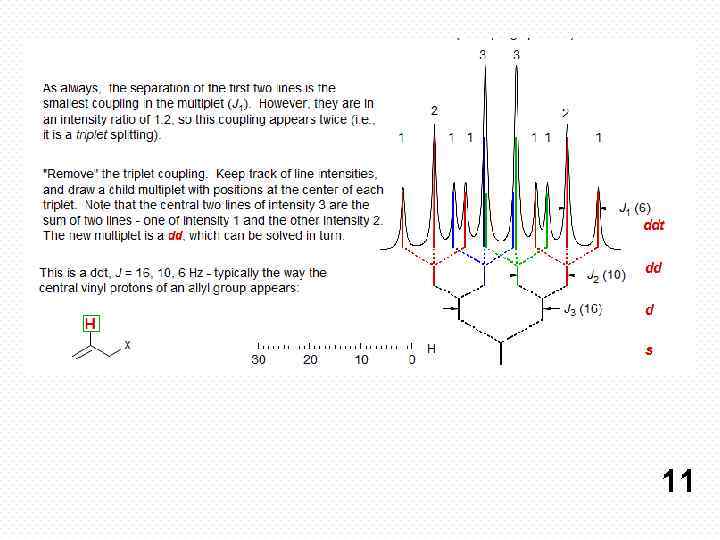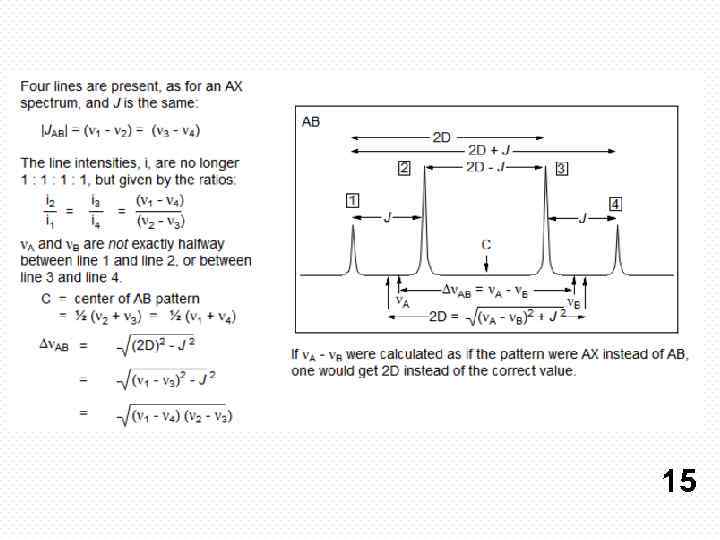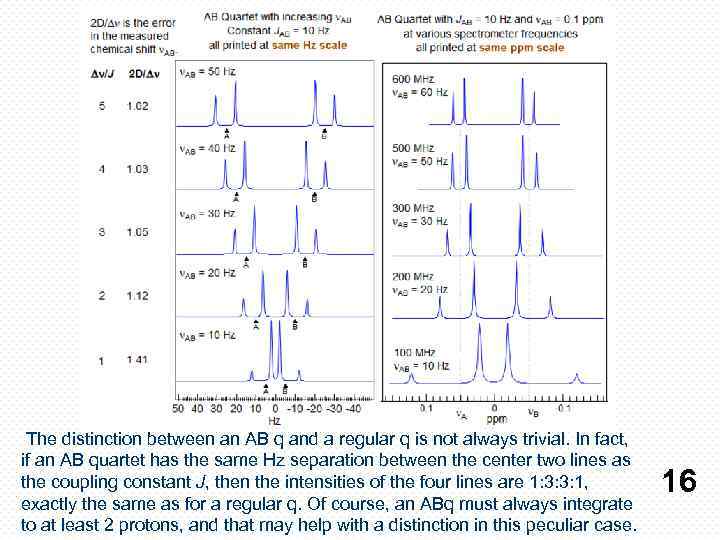ЯМР спектроскопия 4.pptx
- Количество слайдов: 28
 ЯМР спектроскопия для химиков-органиков Научная школа-семинар
ЯМР спектроскопия для химиков-органиков Научная школа-семинар
 2
2
 3
3
 4
4
 The proton-proton couplings in benzene are typically 7 -9 Hz for Jortho, 2 -3 Hz for Jmeta and <1 Hz for Jpara. the doublet at δ 8. 2 with J = 2. 5 Hz , the doublet of doublets at δ 7. 95 (J = 8. 5, 2. 3 Hz), The doublet at δ 7. 6 (J = 8. 5 Hz) 5
The proton-proton couplings in benzene are typically 7 -9 Hz for Jortho, 2 -3 Hz for Jmeta and <1 Hz for Jpara. the doublet at δ 8. 2 with J = 2. 5 Hz , the doublet of doublets at δ 7. 95 (J = 8. 5, 2. 3 Hz), The doublet at δ 7. 6 (J = 8. 5 Hz) 5
 First Order Coupling Rules 1. Nuclei must be chemical shift nonequivalent to show obvious coupling to each other. Thus the protons of CH 2 Cl 2, Si(CH 3)4, Cl-CH 2 -Cl, H 2 C=CH 2 and benzene are all singlets. Equivalent protons are still coupled to each other, but the spectra do not show it. There are important exceptions to this rule: the coupling between shift equivalent but magnetically inequivalent nuclei can have profound effects on NMR spectra 2. J coupling is mutual, i. e. JAB = JBA always. Thus there is never just one nucleus which shows J splitting - there must be two, and they must have the same splitting constant J. However, both nuclei need not be protons - fluorine (19 F) and phosphorus (31 P) are two other common nuclei that have spin ½ and 100% abundance, so they will couple to all nearby protons (the other 100% spin 1/2 nuclei are 89 Y, 103 Rh). If these nuclei are present in a molecule, there are likely to be splittings which are present in only one proton multiplet (i. e. not shared by two multiplets). 3. Two closely spaced lines can be either chemically shifted or coupled. It is not always possible to distinguish J from δ by the appearance of the spectrum. For tough cases (e. g. two closely spaced singlets in the methyl region) there are several posibilities: · decouple the spectrum · obtain it at a different field strength (measured in Hz, coupling constants are field independent, chemical shifts are proportional to the magnetic field) · measure the spectrum a different solvent (chemical shifts are usually more solvent dependent than coupling constants, benzene and chloroform are a good pair of solvents). 6
First Order Coupling Rules 1. Nuclei must be chemical shift nonequivalent to show obvious coupling to each other. Thus the protons of CH 2 Cl 2, Si(CH 3)4, Cl-CH 2 -Cl, H 2 C=CH 2 and benzene are all singlets. Equivalent protons are still coupled to each other, but the spectra do not show it. There are important exceptions to this rule: the coupling between shift equivalent but magnetically inequivalent nuclei can have profound effects on NMR spectra 2. J coupling is mutual, i. e. JAB = JBA always. Thus there is never just one nucleus which shows J splitting - there must be two, and they must have the same splitting constant J. However, both nuclei need not be protons - fluorine (19 F) and phosphorus (31 P) are two other common nuclei that have spin ½ and 100% abundance, so they will couple to all nearby protons (the other 100% spin 1/2 nuclei are 89 Y, 103 Rh). If these nuclei are present in a molecule, there are likely to be splittings which are present in only one proton multiplet (i. e. not shared by two multiplets). 3. Two closely spaced lines can be either chemically shifted or coupled. It is not always possible to distinguish J from δ by the appearance of the spectrum. For tough cases (e. g. two closely spaced singlets in the methyl region) there are several posibilities: · decouple the spectrum · obtain it at a different field strength (measured in Hz, coupling constants are field independent, chemical shifts are proportional to the magnetic field) · measure the spectrum a different solvent (chemical shifts are usually more solvent dependent than coupling constants, benzene and chloroform are a good pair of solvents). 6
 4. Chemical shifts are usually reported in δ (units: ppm) so that the numeric values will not depend on the spectrometer frequency (field-independent units), coupling constants are always reported in Hz (cycles per second). Chemical shifts are caused by the magnetic field, couplings are field-independent, the coupling is inherent in the magnetic properties of the molecule. However, all calculations on NMR spectra are done using Hz (or, more precisely, radians per sec). 5. Protons two (2 J, geminal) or three bonds (3 J, vicinal) apart are usually coupled to each other, more remote protons (4 J, 5 J) may be if geometry is right, or if π-systems (multiple bonds) intervene. Long range couplings (4 J or greater) are usually small, typically <0. 5 Hz, but up to 3 Hz in some cases where there are intervening π bonds. 6. Multiplicity for first order patterns follows the "doubling rule". If all couplings to a particular proton are the same there will be 2 n. I+1 lines, where I is the spin and n is the number of neighboring nuclei (n + 1 for 1 H I = 1/2). The intensities will follow Pascal's triangle. 7
4. Chemical shifts are usually reported in δ (units: ppm) so that the numeric values will not depend on the spectrometer frequency (field-independent units), coupling constants are always reported in Hz (cycles per second). Chemical shifts are caused by the magnetic field, couplings are field-independent, the coupling is inherent in the magnetic properties of the molecule. However, all calculations on NMR spectra are done using Hz (or, more precisely, radians per sec). 5. Protons two (2 J, geminal) or three bonds (3 J, vicinal) apart are usually coupled to each other, more remote protons (4 J, 5 J) may be if geometry is right, or if π-systems (multiple bonds) intervene. Long range couplings (4 J or greater) are usually small, typically <0. 5 Hz, but up to 3 Hz in some cases where there are intervening π bonds. 6. Multiplicity for first order patterns follows the "doubling rule". If all couplings to a particular proton are the same there will be 2 n. I+1 lines, where I is the spin and n is the number of neighboring nuclei (n + 1 for 1 H I = 1/2). The intensities will follow Pascal's triangle. 7
 If all couplings are different, then the number of peaks is 2 n for 1 H, and the intensities are 1: 1: 1: . . Thus a proton coupled to two others by different couplings gives a dd (doublet of doublets, see Figure). This pattern is never called a quartet. As the number of couplings gets larger, accidental superpositions of lines will sometimes occur, so that the 1: 1: 1. . . intensity ratio no longer applies. The intensities are also often distorted by leaning effects (see AB/AX patterns), as seen in several examples below. 8
If all couplings are different, then the number of peaks is 2 n for 1 H, and the intensities are 1: 1: 1: . . Thus a proton coupled to two others by different couplings gives a dd (doublet of doublets, see Figure). This pattern is never called a quartet. As the number of couplings gets larger, accidental superpositions of lines will sometimes occur, so that the 1: 1: 1. . . intensity ratio no longer applies. The intensities are also often distorted by leaning effects (see AB/AX patterns), as seen in several examples below. 8
 9
9
 10
10
 11
11
 Разрешение мультиплетов на приборах с разной рабочей частотой )) 12
Разрешение мультиплетов на приборах с разной рабочей частотой )) 12
 Protons or groups of protons form simple multiplets only if the chemical shift differences between the protons (Δν) are large compared to the coupling constants between them (J). If Δν /J (all in Hz) is <5 then second order effects appear which complicate the analysis. When Δν /J < 1 then second order effects become very pronounced, often preventing detailed manual interpretation of multiplets, or giving incorrect coupling constants if first order behavior is assumed. If the chemical shift between the protons HA and HX is large compared to the coupling between them (νAX >> JAX), we label them as AX. If the chemical shift is comparable to the coupling between the protons (νAB < 5 JAX), we have an AB system. We can define a hierarchy of coupling patterns which show increasingly larger number of second-order effects: AX and all other first order systems (AX 2, AMX, A 3 X 2, etc. ) AB (line intensities start to lean, J can be measured, δ has to be calculated) AB 2 (extra lines, both J and δ have to be calculated) ABX, ABX 2, ABX 3, JAB can be measured, others require a simple calculation ABC (both J and δ can only be obtained by computer simulation) AA'XX' (these do not become first order even at higher fields) AA'BB'X (etc) 13
Protons or groups of protons form simple multiplets only if the chemical shift differences between the protons (Δν) are large compared to the coupling constants between them (J). If Δν /J (all in Hz) is <5 then second order effects appear which complicate the analysis. When Δν /J < 1 then second order effects become very pronounced, often preventing detailed manual interpretation of multiplets, or giving incorrect coupling constants if first order behavior is assumed. If the chemical shift between the protons HA and HX is large compared to the coupling between them (νAX >> JAX), we label them as AX. If the chemical shift is comparable to the coupling between the protons (νAB < 5 JAX), we have an AB system. We can define a hierarchy of coupling patterns which show increasingly larger number of second-order effects: AX and all other first order systems (AX 2, AMX, A 3 X 2, etc. ) AB (line intensities start to lean, J can be measured, δ has to be calculated) AB 2 (extra lines, both J and δ have to be calculated) ABX, ABX 2, ABX 3, JAB can be measured, others require a simple calculation ABC (both J and δ can only be obtained by computer simulation) AA'XX' (these do not become first order even at higher fields) AA'BB'X (etc) 13
 АВ и АХ паттерны 14
АВ и АХ паттерны 14
 15
15
 The distinction between an AB q and a regular q is not always trivial. In fact, if an AB quartet has the same Hz separation between the center two lines as the coupling constant J, then the intensities of the four lines are 1: 3: 3: 1, exactly the same as for a regular q. Of course, an ABq must always integrate to at least 2 protons, and that may help with a distinction in this peculiar case. 16
The distinction between an AB q and a regular q is not always trivial. In fact, if an AB quartet has the same Hz separation between the center two lines as the coupling constant J, then the intensities of the four lines are 1: 3: 3: 1, exactly the same as for a regular q. Of course, an ABq must always integrate to at least 2 protons, and that may help with a distinction in this peculiar case. 16
 17
17
 Graphical method for determining the position of a leaning coupled partner. The point Q is the horizontal projection of the tip of line 2 on the position of line 1, and point P is the projection of the line 1 on the position of line 2. The line through P and Q intersects the baseline at the midpoint between the chemical shifts of A and B (point C) (http: //www. ebyte. it/library/docs/kts/KTS iso. AB Geometry. html). You can use this method to quickly estimate where a leaning doublet's coupling partner should be, if other peaks obscure the region of interest, or to determine whether you are looking at a leaning doublet, or two unrelated peaks. 18
Graphical method for determining the position of a leaning coupled partner. The point Q is the horizontal projection of the tip of line 2 on the position of line 1, and point P is the projection of the line 1 on the position of line 2. The line through P and Q intersects the baseline at the midpoint between the chemical shifts of A and B (point C) (http: //www. ebyte. it/library/docs/kts/KTS iso. AB Geometry. html). You can use this method to quickly estimate where a leaning doublet's coupling partner should be, if other peaks obscure the region of interest, or to determine whether you are looking at a leaning doublet, or two unrelated peaks. 18
 Shown above is the 60 MHz spectrum of Abel's ketone in CDCl 3 solution. There are three sets of protons that one would expect to form AB quartets. Exercise: Identify them on the structure. 19
Shown above is the 60 MHz spectrum of Abel's ketone in CDCl 3 solution. There are three sets of protons that one would expect to form AB quartets. Exercise: Identify them on the structure. 19
 20
20
 Лирическое отступление об описании ЯМР спектров 21
Лирическое отступление об описании ЯМР спектров 21
 How to report an AB quartet. Journals require that NMR spectra be reported in text format. There are several ways an AB quartet could be reported: 1. Treat the pattern as first order (i. e. , as two doublets). This is OK for AB quartets with a large νAB / JAB ratio, say > 4, where the error in chemical shifts caused by simply taking the middle of each doublet is small: 3. 68 (d, 1 H, J = 10. 3 Hz), 3. 79 (d, 1 H, J = 10. 3 Hz) 2. For closely spaced AB quartets (νAB / JAB < 4) the AB character should be explicitly shown, to indicate that the pattern was recognized, and the shifts were calculated correctly. One way is to report the chemical shift of the center of the AB quartet, and ΔδAB and JAB. 2. 66 (ABq, 2 H, ΔδAB = 0. 05, JAB = 12. 2 Hz) 3. A third way is to report the two chemical shifts, and the coupling. 2. 63, 2. 69 (ABq, 2 H, JAB = 12. 2 Hz) Note that the latter two formats not only use less journal space but also contain more information than the "first order" format (1). There is nothing in the first description that specifies that the two doublets are coupled to each other, yet that would be obvious from observing the spectrum . 22
How to report an AB quartet. Journals require that NMR spectra be reported in text format. There are several ways an AB quartet could be reported: 1. Treat the pattern as first order (i. e. , as two doublets). This is OK for AB quartets with a large νAB / JAB ratio, say > 4, where the error in chemical shifts caused by simply taking the middle of each doublet is small: 3. 68 (d, 1 H, J = 10. 3 Hz), 3. 79 (d, 1 H, J = 10. 3 Hz) 2. For closely spaced AB quartets (νAB / JAB < 4) the AB character should be explicitly shown, to indicate that the pattern was recognized, and the shifts were calculated correctly. One way is to report the chemical shift of the center of the AB quartet, and ΔδAB and JAB. 2. 66 (ABq, 2 H, ΔδAB = 0. 05, JAB = 12. 2 Hz) 3. A third way is to report the two chemical shifts, and the coupling. 2. 63, 2. 69 (ABq, 2 H, JAB = 12. 2 Hz) Note that the latter two formats not only use less journal space but also contain more information than the "first order" format (1). There is nothing in the first description that specifies that the two doublets are coupled to each other, yet that would be obvious from observing the spectrum . 22
 13 С ЯМР спектры 23
13 С ЯМР спектры 23
 24
24
 25
25
 26
26
 27
27
 Thanks for your patience and attention 28
Thanks for your patience and attention 28


